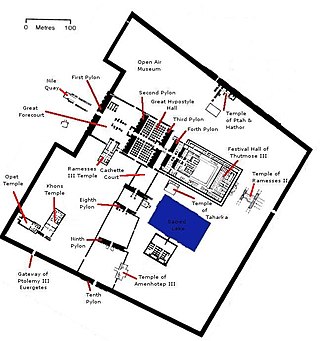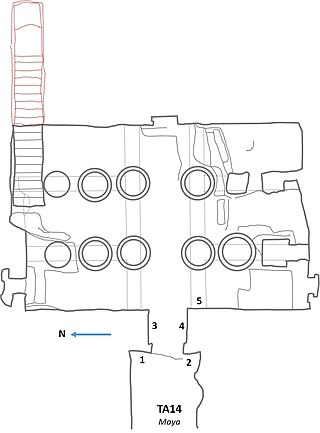
Aten also Aton, Atonu, or Itn was the focus of Atenism, the religious system formally established in ancient Egypt by the late Eighteenth Dynasty pharaoh Akhenaten. Exact dating for the 18th dynasty is contested, though a general date range places the dynasty in the years 1550 to 1292 B.C.E. The worship of Aten and the coinciding rule of Akhenaten are major identifying characteristics of a period within the 18th dynasty referred to as the Amarna Period.

Amarna is an extensive Egyptian archaeological site containing the remains of what was the capital city of the late Eighteenth Dynasty. The city was established in 1346 BC, built at the direction of the Pharaoh Akhenaten, and abandoned shortly after his death in 1332 BC. The name that the ancient Egyptians used for the city is transliterated in English as Akhetaten or Akhetaton, meaning "the horizon of the Aten".

Akhenaten, also spelled Akhenaton or Echnaton, was an ancient Egyptian pharaoh reigning c. 1353–1336 or 1351–1334 BC, the tenth ruler of the Eighteenth Dynasty. Before the fifth year of his reign, he was known as Amenhotep IV.

Amenhotep III, also known as Amenhotep the Magnificent or Amenhotep the Great, was the ninth pharaoh of the Eighteenth Dynasty. According to different authors, he ruled Egypt from June 1386 to 1349 BC, or from June 1388 BC to December 1351 BC/1350 BC, after his father Thutmose IV died. Amenhotep was Thutmose's son by a minor wife, Mutemwiya.

The Temple of Amenhotep IV was an ancient monument at Karnak in Luxor, Egypt. The structures were used during the New Kingdom, in the first four years of the 18th Dynasty reign of the Egyptian Pharaoh Akhenaten, when he still used the name Amenhotep IV. The edifices may have been constructed at the end of the reign of his father, Amenhotep III, and completed by Akhenaten.

The Precinct of Amun-Re, located near Luxor, Egypt, is one of the four main temple enclosures that make up the immense Karnak Temple Complex. The precinct is by far the largest of these and the only one that is open to the general public. The temple complex is dedicated to the principal god of the Theban Triad, Amun, in the form of Amun-Re.
Southern Tomb 23 is a sepulchre in Amarna, Egypt. It was used for the burial of Any, whose titles included, Royal scribe, Scribe of the offering-table of the Aten, Steward of the estate of Aakheperura.

Panehesy was an Egyptian noble who bore the titles of 'Chief servitor of the Aten in the temple of Aten in Akhetaten'.

Malkata, is the site of an Ancient Egyptian palace complex built during the New Kingdom, by the 18th Dynasty pharaoh Amenhotep III. It is located on the West Bank of the Nile at Thebes, Upper Egypt, in the desert to the south of Medinet Habu. The site also included a temple dedicated to Amenhotep III's Great Royal Wife, Tiy, which honors Sobek, the crocodile deity.

Tomb TT188, located in the necropolis of El-Khokha in Thebes in Egypt, is the tomb of the Steward and King's Cupbearer Parennefer. It has been excavated by the Akhenaten Temple Project. The work has been thoroughly published by Susan Redford with architectural study and drawings by Keith Meikle.
The Workmen's Village, located in the desert 1.2 kilometres (0.75 mi) east of the ancient city of Akhetaten, was built during the reign of the Eighteenth Dynasty pharaoh Akhenaten. It housed the workers who constructed and decorated the tombs of the city's elite, making it comparable to the better studied Theban workers village of Deir el-Medina. Though an isolated part of Amarna, the Workmen's Village provides many well preserved artifacts and buildings allowing archaeologists to gather much information about how society functioned.

The Great Temple of the Aten was a temple located in the city of el-Amarna, Egypt. It served as the main place of worship of the deity Aten during the reign of the 18th Dynasty pharaoh Akhenaten. Akhenaten ushered in a unique period of ancient Egyptian history by establishing the new religious cult dedicated to the sun-disk Aten, originally an aspect of Ra, the sun god in traditional ancient Egyptian religion. The king shut down traditional worship of other deities like Amun-Ra, and brought in a new era, though short-lived, of seeming monotheism where the Aten was worshipped as a sun god and Akhenaten and his wife, Nefertiti, represented the divinely royal couple that connected the people with the god. Although he began construction at Karnak during his rule, the association the city had with other gods drove Akhenaten to establish a new city and capital at Amarna for the Aten. Akhenaten built the city along the east bank of the Nile River, setting up workshops, palaces, suburbs and temples. The Great Temple of the Aten was located just north of the Central City and, as the largest temple dedicated to the Aten, was where Akhenaten fully established the proper cult and worship of the sun-disk.
Mahu was Chief of Police at Akhetaten.
The North City was an administrative area in the ancient Egyptian city of Amarna in Upper Egypt, the short-lived capital of Pharaoh Akhenaten of the 18th Dynasty. It contains the ruins of royal palaces, especially the Northern Palace and other administrative buildings and occupies an area between the river and the cliffs that terminate the plains to the north of the city itself.
The Tomb of Meryra is part of a group of tombs located near Amarna, Upper Egypt. Placed in the mountainsides, the graves are divided into north and south groupings; the northern tombs are located in the hillsides and the southern on the plains. Meryra's burial, identified as Amarna Tomb 4 is located in the northern cluster. The sepulchre is the largest and most elaborate of the noble tombs of Amarna. It, along with the majority of these tombs, was never completed. The rock cut tombs of Amarna were constructed specifically for the officials of King Akhenaten. Norman de Garis Davies originally published details of the Tomb in 1903 in the Rock Tombs of El Amarna, Part I – The Tomb of Meryra. The tomb dates back to the 18th Dynasty.
The use of urban planning in ancient Egypt is a matter of continuous debate. Because ancient sites usually survive only in fragments, and many ancient Egyptian cities have been continuously inhabited since their original forms, relatively little is actually understood about the general designs of Egyptian towns for any given period.

Kom el-Nana is an archaeological site near the ancient Egyptian city of Akhet-Aten. It lies south of the city and east of the modern village of el-Hagg Quandil. For a long time its ruins were thought to be those of a Roman military camp, but between 1988 and 2000 Barry Kemp excavated remains of an Amarna period stone temple with garden and subsidiary buildings including a bakery and a brewery. Neither the original name nor the owner of the complex has been identified. It is likely to have been a sun temple and is very similar to Maru-Aten. It consists of a brick enclosure with an area of 228×213 m; it is divided into two unequal parts by an east-west wall. It is likely that pylon gates opened on all four outer walls. Since it stood at a very prominent place – at the southern end of the so-called Royal Road, the main street of Akhet-Aten – it's possibly identical with the sunshade temple of Nefertiti mentioned on the boundary stelae.

Amarna Tomb 3 is a rock-cut cliff tomb located in Amarna, Upper Egypt. The tomb belonged to the Ancient Egyptian noble Ahmes (Ahmose), who served during the reign of Akhenaten. The tomb is situated at the base of a steep cliff and mountain track at the north-eastern end of the Amarna plains. It is located in the northern side of the wadi that splits the cluster of graves known collectively as the Northern tombs. Amarna Tomb 3 is one of six elite tombs belonging to the officials of Akhenaten. It was one of the first Northern tombs, built in Year 9 of the reign of Akhenaten.
The North Riverside Palace was a royal residence in the former Egyptian city of Amarna. This palace should not be confused with the North Palace, which was the residence of first Queen Kiya and later Meritaten.

May was an ancient Egyptian official during the reign of Pharaoh Akhenaten. He was Royal chancellor and fan-bearer at Akhet-Aten, the pharaoh's new capital. He was buried in Tomb EA14 in the southern group of the Amarna rock tombs. Norman de Garis Davies originally published details of the Tomb in 1908 in the Rock Tombs of El Amarna, Part V – Smaller Tombs and Boundary Stelae. The tomb dates to the late 18th Dynasty.
















